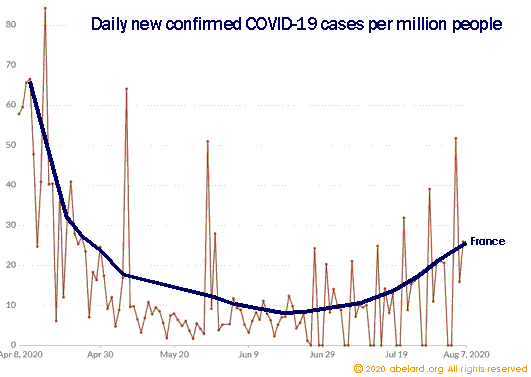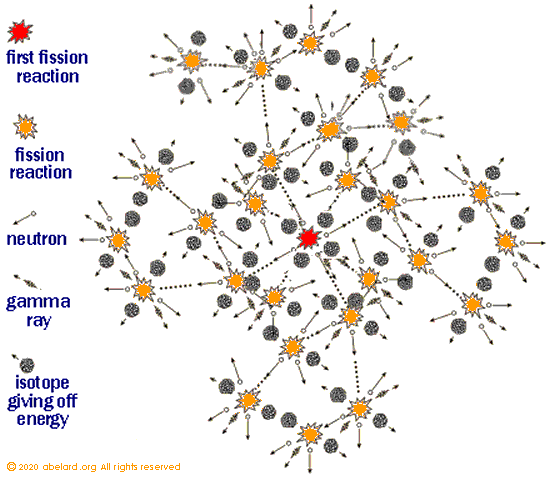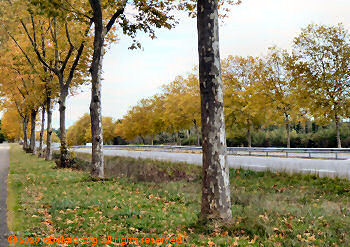- I shall use the Covid-19 pandemic or panic, and its progression in the Great Britian as the example for this document, but the logic being discussed here can be applied to many other, and different, circumstances.
An R (reproduction rate) number of 1 means that you will infect one other person in a given time period.
As present knowledge of Covid is very limited, there is not enough data to be sure how long a person remains infectious. Nor are we sure how long the virus can remain infective on various surfaces and conditions.
The bottom line is that the number for Covid includes an element of 'by guess and by god'.
infection, ideas and nuclear bombs
- According to the UK government, the UK magic number is point 7 [.7] to 1 at present.
- The politicians and media have played with .6 to .9.
- Clearly .6 is ridiculous - this week.
- The magic number applies to Great Britain,
not to Sussex, Wales or Scotchland.
- Each defined sub-unit will have its own magic number.
The EUSSR has separated from its pretences.
Each member
country will now have a magic number,
which many
will exaggerate or minimise as political desires
drive them.
Maybe soon, we'll have a magic number league.
- Locking down a unit like London or a 'care home' makes some
sense.
Locking down the Isle of Mull does not if they have
no cases.
- But as everyone is equal as long as they are not, you cannot let Scotchies go out if Londoners cannot.
It just would not be 'fair'.
- But it will be fair if Spain opens up and Italy does not.
Unless you are a Catalan or Dogatist.
to mask or not to mask
- It is obvious that masks will lower the magic number (R) as does keeping 6 feet apart, instead of 5 feet.
The magic number is a matter of lowering risks, not eliminating risks.
- However, if the NHS wants masks they must have priority. So let's
pretend masks will not work,
until we have enough to sell.
- Lower the magic number below one and, in due course, the disease will die out.
The
lower the number goes, the faster Covid19 will die out (attenuate). Of course, it could continue in the environment with occasional breakouts.
the 'psychology' of an infection - the clever virus
- Infections and so on do not just keep on spreading - they are self-limiting.
The disease ends when it runs out of people who are neither immune nor dead.
- • A clever virus does not kill victims - it tries to change itself so it can have another go round - that is called mutating. A clever virus mutates well.
• A clever virus does not kill its victim/host - thus providing the host the ability to continue infecting others, and so spread the virus further.
• A clever virus is highly contagious, and so more easily caught by others, increasing the spread rate.
- The R number is the rate at which an entity, in this case a virus or the disease it provokes, replicates/reproduces. (R numbers, or R rates, can also apply to deaths.)
- An R number is not a forecast.
- R varies from zero (0) to any higher, positive number.
R = 4 indicates that
one person infects four others.
R = .5 means two people are needed to infect one other person, on average.
- The greater the magic number R is above R = 1, the faster the infection spreads.
The lower the magic number is below R = 1, the more the infection attenuates (reduces).
- The magic number, and the infection, cannot go lower than zero.
An infection with an R below 1, for instance R = .7, dies out over time.
As the infection finds more hosts/homes, R cannot be larger than the whole population.
- The R number can apply to the rate of infection, or to the number of deaths, for a village, a country, or a care home.
- There is not a single R outside a context and the R number can vary over time.
R and time contexts
 Covid-19 cases in France, 2020. [derived image]
Covid-19 cases in France, 2020. [derived image]
These R numbers are averages. Thus, on average, a infected person may infect one other person per week, or per month.
If it is one infection per week and the R number is measured over one week, then R will be 1.
If R is measured over two weeks while the infection rate (R) remains at an average of 1 per week, then R may be 3 over those two weeks - the original, already infected person, A, infects two other people during two weeks, while the first person contaminated by A will go on to infect one other person in the second week.
Maybe the infection is Covid and you remain infectious for two weeks, or maybe the infection is leprosy or syphilis and you can go on infecting others for many years.
R number, social distancing, and crowding
 Degree of contact depends on distancing
Degree of contact depends on distancing
These are time and space measurements.
The diagram above compares contagion (ability to catch an infection) for an infection when in a town and when in the countryside. Obviously, you are more likely to come in contact with another person who is infected in town than in the country, over a particular time frame.
Of course, you live in a monastery, or work in a school, or even a department store, it is likely that you will make more contacts than if you are a shepherd - unless, of course, it is market day.
Thus you will see a major variable in the spread of infection is a matter of crowding.
In densely populated England or Netherlands, your risks will be considerably higher than in more sparsely occupied France unless, of course, your culture inclines you to cuddle and kiss everyone you meet.
The number of people an individual infected and the so-called R number
can be confusingly intermixed.
- Now look at the world from the point of view of the bug (in the case of Covid, a virus).
If she kills her victim within a week, as say with Ebola, she is far less successful that if she keeps her victim or target alive for years. Evolution works on bugs, just as on any other creature, and teaches them the best strategies for a long life and plentiful descendants.
Covid has chosen humans and, allegedly bats, as victims or homes for its offspring. In due course, Covid runs out of new victims. There are always a limited number of homes in the real world. As more and more of the target population become infected, advanced creatures tend to develop immunity. In due course, poor old Covid is liable to run out of victims, or houses. Then, Covid is likely to be less inclined to kill its victims. Somewhere around this point, humans may well be able to live with the pests, at which point they are said to have developed herd immunity.
There are many pests, and other creatures, with which humans have learned to live.
-
uranium fission

approximate illustration of uranium fission
- A nuclear reaction does not happen all at once. One particle will split shortly after another, and its products may or may not arrive at other particles that are splitting.
- A nuclear reaction is the result of more particles splitting.
- In a nuclear reaction, the uranium 235 atoms are eiher kept apart or squashed together in a nuclear power station. This is done to control the power generated, or it can be to set off a bomb. The closer the particles are crowded together, the more likely the neutrons are to to find another particle to split, thus forming a chain reaction.
While the pattern of all these processes is similar, the timings are radically different. Time is a vital element in understanding any real-world process. An atomic explosion happens extremely quickly - indeed, that is what "explosion" means. A chemical bomb is just a chemical reaction that takes place very quickly - you may think of it as a very fast fire. Wood can be made to burn very quickly if it is chopped into very small pieces.
Explosions are not unknown in saw mills if sawdust accumulation is not controlled.
- This arithmetic applies to the inventions and to the spread of ideas (memes) through a society - for instance, a new and better mousetrap. It also applies to chain reactions.
- A forecast is a prediction, a guess. It is not and cannot be reality. However clever the algorithm for creating the forecast, however pretty and seductive the graphs, the result is still just a guess, maybe better than looking into a mystic's glass ball, but no guarantees.
- All statistics depend on the ASSUMPTION that the future will be the 'same' as for the past (see also why Aristotelian
logic does not work and Cause, chance and Bayesian statistics). However, it will not be - ever. Your best hope is that it will not be different enough to matter to you.
- The idea of models and modelling is often confusing and confused in writings on mathematics. Perhaps the word 'comparing' would be better than 'modelling'.
- You will often come across "model this data" against the normal, Gaussian, or bell curve (the same).
In other places, you come across "model a mathematical theory" such as quadratic equations against reality, which means check the model against reality.
- You will find that I always prioritise reality, while regarding theory as subordinate and unreliable. This 'conflict' is at the heart of understanding statistics.
- Theoretical models such as the normal curve are often referred to as parametric statistics, whereas Bayesian statistics that focus on the real world are commonly called non-parametric statistics, or even empric.
- I shall give you a couple of examples.
Tossing a penny, you will be told, always comes down heads or tails (unless it lands on its edge!).
Therefore, there is a 50% chance (half) of it landing heads, and the same for the coin landing tails.
Bayesian statistics approaches this in an entirely different and empiric manner. Toss the penny ten times and have seven heads, the probability of heads is .7 and tails .3. That is, the real world takes precedence over the theory. Whether you decide that is enough reason to shoot the owner of the penny is entirely a matter of your view of the real world.
- Parallel arguments and reasoning apply to a croupier with dice at a craps table, or spinning a roulette wheel.
- Now back to Covid or any other medical experimentation.
where every test is 'unreliable' and every subject/patient is different,
and a Bayesian approach is more intelligent.
- Over time, humans have learnt to think of things/objects as separated unto different categories, as accords with human uses and convenience.
- And then to count those supposed objects with magic incantations called numbers.
- Thus, you may count trees 'one' for 1, 'two' for 2, 'three' for 3 and so on (arabic numerals). These integers can be used to model your perception of the trees, or the trees to model the numbers (sometimes this is called mapping).
- After counting a few trees, you may well come to expect another, and another, and another, and start to forecast the next tree. Look there's a next one, and another, but then the trees stop. Remember, you cannot forecast the future, forecasts are guesses, just as anticipating yet another tree is a guess.
- The sizes of the trees can be amusingly regarded as distributed 'at random' or 'by chance'.
options for lowering the Covid-19 R number - In a city, the natural expansion rate of a disease, the R number, may be 2.
Living in the country, the R number may be 1.
Such numbers can be found from empiric data.
- Here are some options for bringing down the Covid-19 R number to below 1:
• keep off public transport;
• don't shake hands;
• don't touch metal or plastic surfaces.
And here are some further recommendations:
• wear a mask;
• wash hands every 2 minutes;
• keep 2 metres, 3 metres, more from anyone else;
• don't get into cars with strange men.

The dimensions of the markings did not cause the girth of the trees,
nor visa versa |

After counting a few trees, you may well come to expect another, and another, and another |
- How much is any such precaution related to a disease, in this case Covid-19?
- What use is such data to you? Various genetic prepositions may leave one person dead and another without symptoms.
- The number of inches in a tree's diameter may correlate highly, or have little or no relationship with the road markings, or even the distance between trees.
- Correlation is no more than a guess or a guide.
- David Hume (1711-1776) and cause
Although people gain much information from their impressions, most matters of fact depend upon reasoning about causes and effects, even though people do not directly experience causal relations. What, then, are causal relations? According to Hume they have three components: contiguity of time and place, temporal priority of the cause, and constant conjunction.
In order for x to be the cause of y, x and y must exist adjacent to each other in space and time, x must precede y, and x and y must invariably exist together. People do not experience and do not know of any power, energy, or secret force that causes ‘possess’. Judgements about causes and their effects are based upon experience.
To cite examples from An Enquiry Concerning Human Understanding (1748). There is nothing in the experience of seeing a fire close by which logically requires that one will feel heat. There is nothing in the experience of seeing one rolling billiard ball contact another that logically requires the second one to begin moving, why does one expect heat to be felt and the second ball to roll?
The explanation is custom (habit). In previous experiences, the feeling of heat has regularly accompanied the sight of fire, and the motion of one billiard ball has accompanied the motion of another. Thus the mind becomes accustomed to certain expectations. "All inferences from experience, therefore, are effects of custom, not of reasoning." Thus it is that custom (experience and memory), not reason, is the great guide of life. In short, the idea of cause and effect is neither a relation of ideas nor a matter of fact. Although it is not a perception and not rationally justified, it is crucial to human survival and a central aspect of human cognition.
Adapted from Encyclopedia Britannica CD 97, (Encyclopedia Britannica Inc.,1997).
- Whether the variables are just numbers or a political decision, they are not a scientific call. The decision remains your choice. Political decision for an individual is primarily and wholly choice, and is driven by personal advantage. The experts may want position and authority, while the plastic duck manufacturer wants to make a dollar a duck.
- The numbers do not tell you what to do. If a thousand a day die, this does not mean businesses have to close, or open spaces have to shut. You can take dozens of different precautions, but you do not know how effective any one may be.
- The numbers ('statistics') remain averages.
The probability of being infected is the combination of several factors, including not just whether you use a mask but also your genetics and which type of mask is used.
- A further level : your situation depends on your personal circumstances - at age 20, I do not mind being ill.
At age 87, I do mind being ill - the probable outcomes are likely much worse and more probable.
- You have two immune systems:
1 innate
2 adaptive
- The common cold is a symptom, not a disease.
Some strains of covid cause colds.
- Usually, the common cold is killed off by the
innate immune system.
- The adaptive immune system doesn't kick in until after about one week.
It is the adaptive system that produces antibodies.
- Most covid colds are done in by the innate immune system
within three or four days, so there are no antibodies.
- It is the old and weak who do not throw off covid. When they don't throw off covid, it can go on to cause
other problems like pneumonia and sometimes
cytokine storm reactions.
- Known, available data changes over time.
- Over time, people understand any situation better. Thus, government starts by shutting down the whole of society. Then as it is recognised that Covid is only killing the aged, or perhaps the already infirm and the fat, government policy becomes that is is only mainly those groups that need sheltering. Of course, polticians will lock down the whole of society under various motives, such as never admit that you are wrong, a will to control, and a fear of opponents suggesting that the government is uncaring.
- The constantly changing nature of reality is a reason for using Bayesian rather than parametric statistics.
- To be continued.
further reading
- on flu pandemics
What happened during the 1918 flu pandemic? Are we
in for something similar now? How flu acts. With some
safety advice.
- on vaccines
The reliability of vaccines; treatment risks and benefits;
cervical cancer vaccines, cervarix and gardasil; on
human papillomavirus
- on immunology
Finding your way more easily through the jargon-loaded
sources on the area of immunology.

advertisement
|





















